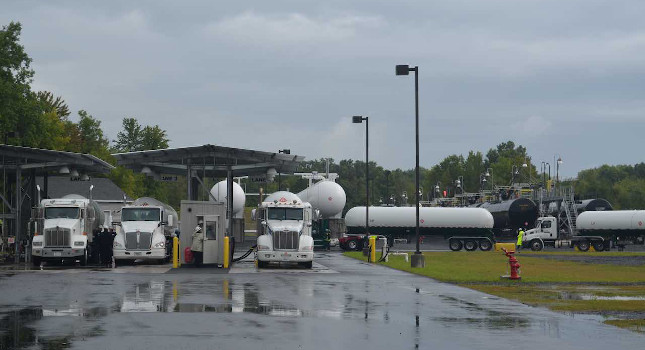Rail terminals save money by minimizing distances and time

Many company managements recall the 2013-14 winter, which challenged all to endure and, in some cases, address supply and distribution concerns and major price spikes. The winters that followed were relatively uneventful in terms of supply and storage discussions, but the end of 2019 brought the industry back to this conversation.
Farmers faced a wet and cold harvest, causing substantial propane demand for crop drying, animal heat and residential space heating. The industry struggled to keep up. The problem in 2019, however, was not so much about supply, but rather storage and logistics.
Over the past five years, midstream propane suppliers and retailers across the country worked to increase storage capacity through the addition of rail terminals, allowing local marketers unfettered access to reliable propane supply. Rail is key to moving propane where it is needed, especially when end users are not located in proximity to a propane pipeline. Strategically placed rail-supplied terminals help stabilize prices for local and regional propane providers by reducing the distance traveled to procure transport loads of product needed in rural areas, including much of the U.S. north and Midwest, where agriculture and heating needs are often urgent and extreme.
How do rail terminals work?
In a rail-supplied propane terminal, including the 15 Superior Energy Systems has built in the past five years (see Figure 1), product that is primarily sourced from shale plays is offloaded from railcars using compressors, stored and then loaded via pumps into trucks that transport the product to bulk plants, which in turn load local transport vehicles like bobtails.
Overall design and storage need to be addressed first when building a rail-based terminal operation. Distances and aggregate storage capacities (i.e., total storage available) can place limits on storage and rail capabilities. It is critical to assess necessary storage required to meet regional peak demand. The midstream supplier must assess past purchases, logistics associated with moving fuel from nearby refineries, and geographic needs based on historical data, and supply and demand.
The keys to success
The most critical part of building an advanced railcar-supplied propane terminal lies in efficiency in both rail switches and the unloading of propane tank railcars. The responsibility of the rail switch falls on either the midstream marketer/terminal owner or the railroad operator.
When a rail terminal is built, many logistical motions come into play related to the movement or addition of track, the amount of railcar storage and the necessity of separate (on- or off-site) railcar storage sites. The efficient unloading of tank railcars affects the entire terminal operation, determining the speed that gas is unloaded and subsequently, the number of tanker trucks that can be loaded in a given amount of time. Compressor size and unload pressures make a crucial difference in offload speed, as does the process used to remove the propane. Top connections are used to remove liquid propane, due to the nature of the fuel. Vapor removal and recovery is a significant detail that must be accounted for as well, to avoid losing potentially thousands of gallons of fuel.
Also important in rail terminal efficiency is the truck transport loading process. At the truck loading rack, truck-metering skids are calibrated for accurate custody transfer. Automation is also key; bill of lading management, the programmable logic controller (PLC), tank level system and terminal management software all come together to benefit both the propane retailer and the end-user customer. Additional automated features, such as a lockable gate control system, must be installed to meet National Fire Protection Association NFPA 58 code, the industry benchmark for safe propane gas storage, handling, transportation and use.
Location is everything
One of the newest propane rail terminals is owned and operated by Tri Gas & Oil, which operates as an affiliate of Mid-Atlantic Rail Services (MARS). (See Figure 2.) Conveniently located just north of Baltimore Harbor off Interstate 95, the terminal allows trucks access to bulk propane product. Fuel transport trucks in Maryland are prohibited from entering the tunnel system, typically traveling over bridges instead. The strategic location of MARS allows for the convenient use of the Francis Scott Key Bridge when accessing from the south of Baltimore.
The new terminal, served by Norfolk Southern and CSX railroads and opened early fall 2019, provides 120,000 gallons of propane storage, along with a four-position rail rack and two truck loading racks. Double-acting compressors quickly unload and recover vapor from railcars. Turbine pumps allow for loading rates of 550 gallons per minute, with capability to load up to six trucks per hour, at an average rate of 18 minutes per truck. Local daily switching service from the Canton Railroad provides up to three switches a day in the peak of winter. This translates to product delivered into as many as 36 trucks per day when it is needed most.
For the Northeast
Crestwood Services also brought a new propane terminal online in fall 2018 in Montgomery, N.Y., that plays a crucial role in efficiently delivering propane to strategic and previously underserved markets in the U.S. Northeast. The facility, one of the largest in the country, occupies 20 acres and is equipped to store more than 280,000 gallons of propane. The terminal helps reduce wait times for transports/marketers by allowing them to drive less distance to acquire product and wait a shorter time to load it. There was a clear need for additional propane resources in the northeast, specifically in New York and the New England states. The terminal is conveniently located right off Interstate 84 and provides reliable supply to thousands in the area.
Maximizing the number of offloading stations while maintaining speed of extraction and accuracy provides economical savings to both Crestwood and its customers. The Montgomery facility was complete with 16 rail offloading stations on a continuous platform paired with high performance vapor compressors, which eliminates volume loss. The design provides two switches per day and ensures a capacity of approximately 100 trucks per day, or a volume of 1 million gallons. The four-spot truck rack with turbine pumps will load four trucks in 17 minutes, resulting in reduced wait times and efficient turnarounds. The facility is designed to exceed even the toughest winter supply challenges.
Final words
Making sure propane gets where it needs to be both quickly and safely is the reason so much strategy goes into the development of rail-supplied propane terminals. This benefits the end user, especially in rural areas where agriculture and heating needs are important. In addition, rail terminals save money for propane suppliers by minimizing the distance and time spent to acquire transport loads. That’s a win-win for everyone.



